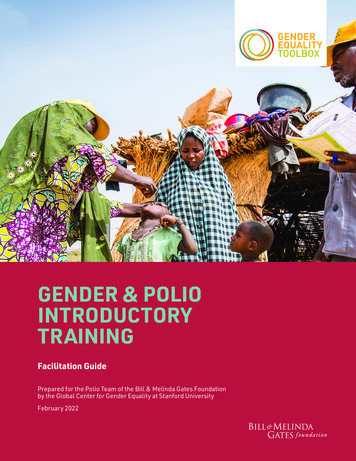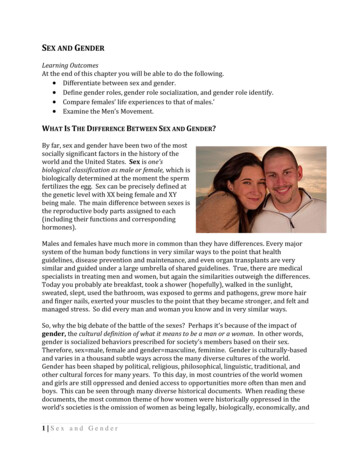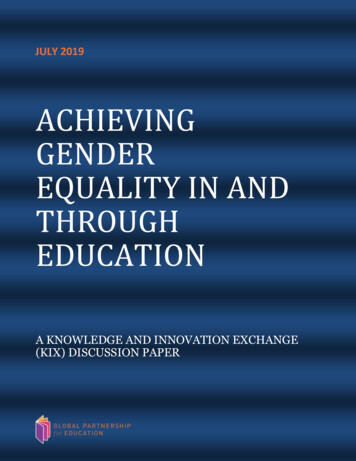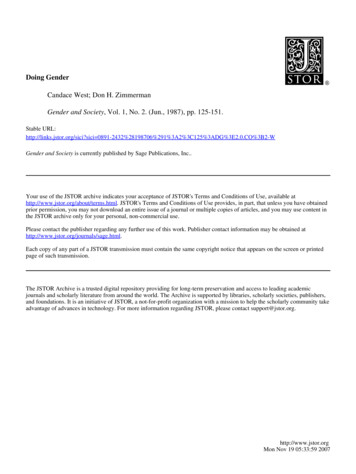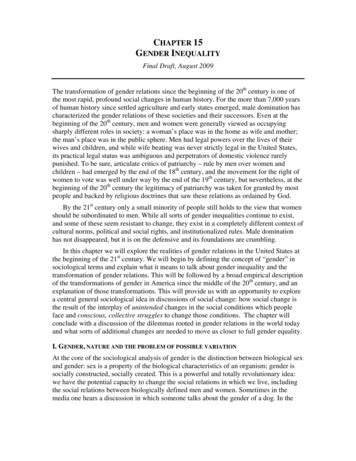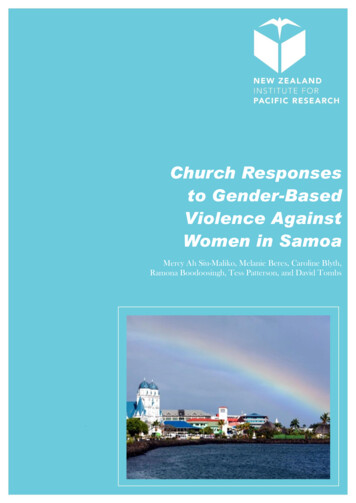
Transcription
Church Responsesto Gender-BasedViolence AgainstWomen in SamoaMercy Ah Siu-Maliko, Melanie Beres, Caroline Blyth,Ramona Boodoosingh, Tess Patterson, and David Tombs
The New Zealand Institute for Pacific Research (NZIPR) was launched inMarch 2016. Its primary role is to promote and support excellence in Pacificresearch. The NZIPR incorporates a wide network of researchers,research institutions and other sources of expertise in the PacificIslands. The University of Auckland, Auckland University ofTechnology and Otago University lead the NZIPR. Its supportpartners include the New Zealand Institute of EconomicResearch, the University of the South Pacific, the AustralianNational University, Peking University, the Universityof Hawaii, the Secretariat for the Pacific Community,the Ministry of Foreign Affairs and Trade andthe Pacific Cooperation Foundation.Cover image: Immaculate Conception Cathedral, Apia
Published byMercy Ah Siu-Maliko, Melanie Beres, Caroline Blyth,Ramona Boodoosingh, Tess Patterson, and David TombsIBSN: 978-0-473-47559-8Page 1
It had been a great privilege to be involved in this research project. Looking backon the duration of the project it is clear that the work would not have beenpossible without generous help and support from many different quarters.The Directors and research managers at the New Zealand Institute ofPacific Research have been consistently supportive and helpful.Associate Prof. Damon Salesa and Dr. Gerard Cotterell accompaniedthe research from the initial proposal into its research phase.Associate Prof. Yvonne Underhill-Sem, Professor RichardBedford, and Dr Evelyn Marsters, guided it to successfulcompletion and final delivery. We thank each one of them.We are also grateful to the Ministry for Foreign Affairsand Trade for the project funding, and especiallyto all those who contributed to the initial workshop in Wellington. The feedback and adviceat the workshop were very helpful in fine-tuning the project approach.The New Zealand High Commissionin Apia also offered invaluable adviceon local project partners and researchconnections. The students and staff of PiulaTheological College, the Samoa Ministry ofWomen, Community and Social Development,and the Centre for Samoan Studies at NationalUniversity of Samoa, were extraordinarily generousin their hospitality and help. Latuivai Kioa Latu helpedto co-ordinate the Piula conference and gave invaluable assistance in the translation of bible studies.The research project received ethical approval from the University ofOtago (Ethics Committee reference 17/080) and the National Universityof Samoa, and the research committees in both institutions were extremelyhelpful in their work. In compiling this publication, we are especially gratefulto the Women’s Study Journal Aotearoa for permission to reproduce workthat was first published in a special issue in December 2018.2
Dr Richard Davis, Dr Seforosa Carroll and Dr Judith McKinlay joined us for our initial workshopin Dunedin. Dr Davis, Rev Prof Feleterika Uili Nokise, and colleagues at the Pacific TheologicalCollege (Suva) also hosted our two-day conference (12-13 April 2018), where we were joined byProf Gerald West and Prof Beverley Haddad of the University of KwaZulu-Natal. Our guestspeakers at the Auckland conferences Rev Dr Joan Alleluia Filemoni-Tofaeono, Prof. MalamaMeleisea, and Dr Nasili Vaka’uta all contributed generously with their time and expertise. St John’sCollege of the Evangelist, especially Rev Dr Frank Smith, and Trinity Methodist College, especiallyDr Emily Colgan, also hosted events in Auckland and contributed to the work of the project.Each one of us on the research team is also grateful to our own institutions for the support that hasmade our collaboration possible, at Piula Theological College, the National University of Samoa,the University of Auckland, and the University of Otago. A wider advisory group including Rev DrMosese Ma’ilo, Rev Ma'afala Lim ā, Rev Dr Selota Maliko, Dr Penelope Schoeffel, Mrs. Silinui LinaChang, Dr Lydia Johnson, Dr Eisabet Le Roux, Prof Beverley Haddad, Dr Jo Cribb, Rev DrTokerau Jospeh, Rev Siosifa Pole, Tofilau Nina Kirifi-Alai, Dr Patrick Vakaoti, Dr Jenny BryantTokalau, Prof Tony Ballantyne, Prof Helen Nicholson, all offered encouragement and advice. Thislist of thanks and acknowledgments is in no way exhaustive. Many others cont ributed in differentways, and although they are not named here, we are deeply grateful to them.In wishing to acknowledge all the help that we received, we also realise that any deficiencies, errorsor omissions in the research are entirely the responsibility of the research team itself, and notattributable to anyone thanked above.Professor David Tombs, University of OtagoPage 3
Tatala Le Ta’ui A Le Atua in Samoan Culture10Defining Gender Based Violence (GBV)10Bible Study Method11Key Objectives19Introduction to the group19Reading the Text As Conversation (NRSV)19Initial Analysis Of Text19Summary of the Text20Background to the Text20Theological Reflection22A Contextual Reflection23Using the Story of Hagar to Raise Awareness of Gender-BasedViolence Against Women (GBVAW)24Questions for Further Reflection24From Awareness to Action25Bibliography and Further Reading26O Le Tosoga Fa’amalosi O4
Key Objectives36Introduction to the Group36Reading the Text as Conversation (NRSV)36Initial Analysis of Text37Summary of Text37Background to the Text39Theological Reflection on the Text39A Contextual Reflection39Using The Story of Tamar to Raise Awareness Of Gender-BasedViolence Against Women41Questions for Further Reflection42From Awareness to Action42Bibliography and Further Reading43Introduction46Samoa: An Overview46Violence Against Women in Samoa: Intersections With LocalGovernance48The Village Governance SystemThe Village Fono4850Gender Disparities in the Fono51The Fono and Violence Against Women51Statistics and Studies of Violence Against Women in Samoa53Support Services in Samoa for People Impacted by Gender-BasedViolence56The Laws, the Police and the Courts: Intersections with TraditionalGovernance Structures57The Crimes Act 201357The Family Safety Act 201358Police Services and Courts in Samoa59The Family Court and Family Violence Court60Page 5
The Samoan Church and Violence Against Women660Potential Within the Churches61Aspects of Church Teaching and Practice Which Contributeto VAW63Opportunities for a Faith-Based Response to ViolenceAgainst ences80
Church membership in Samoa is exceptionally high, and the moral authority andcommunity leadership of churches insociety is widely recognised. The churchesin Samoa therefore have enormouspotential capacity to contribute proactivelyto social well-being. In recent years theSamoan government, the Ministry ofWomen, Community and Social Development, and the National Human RightsInstitute have identified the importance ofprevention initiatives on violence againstwomen (VAW). The Samoan GovernmentSecond Progress Report 2010 has highlighted the need to address violence againstwomen, and identified the contributionthat churches might make towards this:The churches should be heavily involved in addressing violence againstwomen. It is proposed that a specialtaskforce be established with all therelevant authorities to adequatelyanalyse and determine strategic interventions at all levels that wouldaddress violence against women effecttively. The involvement of key NGOssuch as Samoa Victim Support as wellas the National Council of Churcheswould play a key role in consolidatingappropriate interventions that wouldreduce violence against women(Samoan Govt. 2010: 10).International experience suggests thatbiblical texts can promote a significantdifference within churches to attitudes andactions on VAW prevention. A biblicaland faith-based approach is well-placed topromote social change in Samoa. Workwith biblical texts is critical for tworeasons. First it addresses the temptationfor churches to dismiss VAW preventionas a purely secular issue which is of littleconcern to the churches. Second, it offersgenerative resources to critique ways inwhich churches can be part of the problem,and also support discussion of ways inwhich churches might take leadership aspart of the solution.There are some biblical verses that arewidely used to justify or excuse violenceagainst women. However, at the same timethat the selective misuse of biblical textscontributes to the problem, there is alsorecognition that these interpretations shouldbe questioned and challenged. A positivebiblical message promoted by the churchescan, and should, be offered as an effectiveresponse to the misuse of biblical texts. Textsthat affirm the dignity and sacred value ofall people, as created in the image of God,and highlight the destructive consequencesthat violence creates for individual, familiesand communities deserve particular attention.This report is in three main sections. Thefirst section case-studies two group biblestudies developed and piloted during theproject to promote a deeper discussion onVAW. The bible studies are part of alarger bible study resource, which will beavailable in both English and Samoan, forwork in this area. The second sectionoffers a background briefing on VAW inSamoa with particular attention to thechallenges it raises for churches. The thirdsection, emerging from the projectconference in Auckland on 11 June 2018,discusses the creative approach adopted byMercy Ah Siu Maliko in the research.Page 7
Dr Mercy Ah Siu-Maliko (lead researcher) isa Lecturer in Theology at the PiulaTheological College. She received her BAand BTh from the University of Auckland,her MTh from Pacific Theological Collegein Fiji, and her PhD in public theology fromOtago University. Her post- doctoral workfocuses on violence against women in thechurch and Samoan society.Dr Ramona Boodoosingh is Senior Lecturerin the School of Nursing and Health Scienceat the National University of Samoa. Herdoctoral studies explored the supportservices available to victims of violenceagainst women in developing countries,focusing on the experiences of women inSamoa and Fiji. Her current researchinterests include gender-based violence andhealth literacy.Dr Melanie Beres is a Senior Lecturer in theDepartment of Sociology, Gender, andSocial Work at the University of Otago. Herprogramme of research is centred aroundthe concept of sexual consent, with aparticular interest in sexual violenceprevention.Dr Caroline Blyth is Senior Lecturer inReligious Studies at the University of8Auckland. Her research explores thecomplex relationship between gender,sexuality, and religion, focusing particularlyon religious responses to gender-basedviolence. Caroline is also managing co-editorof the Bible and Critical Theory journal and,along with Johanna Stiebert (University ofLeeds) and Katie Edwards (University ofSheffield), leads the Shiloh Project, aninterdisciplinary research group exploringthe intersections that exist between rapeculture and religion.Dr Tess Patterson (project consultant) isSenior Lecturer in the Department ofPsychological Medicine, University ofOtago. Her research interests are in appliedclinical and forensic psychology domains.Professor David Tombs (principalinvestigator) is the Howard Paterson Chairof Theology and Public Issues at theUniversity of Otago. His current researchfocuses on religion and violence, especiallyChristian responses to gender-basedviolence, sexual abuse, and torture. He isoriginally from London, and has previouslyworked in Britain (University ofRoehampton, London) and Ireland (TrinityCollege Dublin).
Page 9
Tatala le Ta’ui a le Atua presents a series of1The word ta’ui has a specific use. It’s a wordused to refer to the finest of fine mats thathas long been pressed and reciprocally caredfor within homes. This delicate fine mat isnot rolled together with other ordinary rollsof mats or anything else. Although the samepandanus leaves are used to weave fine matsand mats used every day, still a mat cannotbe called a treasure, unless it is the finest offine mats. It is a fine mat treasured andprotected. It is a fine mat that is not simplylaid bare, sat on or for someone to trampleon, but a fine mat people respect. It is not anordinary fine mat that is displayed using longsticks to hold it up because of its size. It isone fine mat that can be folded and put inan elderly woman’s woven basket or it canbe simply held in an orator’s hand. Anotherview is that because the fine mat has beenkept for a long time, it can become delicate,shiny, and eye-catching. This is the reasonwhy when such a fine mat is opened orrolled out, those who roll it out literally havegoose bumps and say, “Oh it is the treasureof a noble.” This is the type of fine matseldom rolled out except on special andsignificant occasions; then, such a treasure isrolled out in public. The use of this Samoansaying in this project articulates thesignificant role of scripture as the finest finemat rolled out to transform human relationships damaged by gender-based violenceagainst women and violence in general.GBV is violence that is targeted againstindividuals or groups on the basis of theirgender. This violence is a clear sign ofdeeply entrenched power inequalitiesbetween men and women. While it cutsacross class, ethnicity, religion, ablebodiness, age and location, it primarilyaffects women and girls. The term GBV ishence often interchangeably used with‘violence against women’.2 This violence isoften perpetrated by men, and women andgirls are often the victims. In Samoa andother contexts, GBV always results fromunequal power relationships between menand women. Violence is directed specificallyagainst a woman because she is a woman,1 This concept was proposed by Rev. Latu Kioa toarticulate the connection between the Samoan symbolof fine mat and scripture. The Samoan explanation ofthe term was also written by Kioa in the Samoanlanguage and translated into English by the author.2 http://www.un.org accessed 23 October 2017Bible studies rooted in the importance ofbeing relational in the Samoan culture. Itembraces the belief that the self takes itsform from maintaining relationships. Tatalale Ta’ui a le Atua as a Samoan sayingarticulates the necessity to reconnect withone’s God, ancestors, neighbour/s andenvironment, to reveal a person’s genuineself-identity rooted in the relationship ofrespect, and concurrently, revealing theimage of God in humans.10
and because she has less power than her(male) abuser. GBV includes, but is notlimited to, physical, sexual, andpsychological harm.3This series of Bible studies draws on thework of the Brazilian educator, Paulo Freire.The aim of Freire’s model of transformationis to empower people through the process ofself-awareness or consciousness raising. It isa creative way of enabling people to think forthemselves, so that what they learn becomesauthenticated in their lives. This includes thesharing of ideas, debates, dialogue,discussion, and working with others assubjects rather than as objects.4 Freire, in hiseducational philosophy, advocates that‘Education is the key to liberation.’ ForFreire, education is never neutral. It is‘political’ in the sense that its main objectiveis either to maintain the status quo, or toeducate for liberation.5Using Freire’s method as a guide to doingBible studies serves the following purposes:to develop dialogue, participation, selfidentity, empowerment and confidence inparticipants (men and women); and totransform their spiritual lives.6 This ‘praxiscentred’ methodology attempts to move theparticipants toward ‘reflection-action’exercises that will ultimately bear fruit in theform of empowering and liberating GoodNews for the churches and communitieswhere the participants are situated, andespecially in relation to the issue of GBVagainst women. The designed Bible studiesfollow a specific structure that begins fromraising awareness to concrete action/s as anongoing process, taking into account theimportance of the contexts and needs ofparticipants.3 United Nations Population Fund, Gender ThemeGroup (1998).4 Paulo Freire, Cultural Action for Freedom (Boston,Massachusetts: Harvard University, 1972 ), 27.5 See Mercy Ah Siu-Maliko, "Conscientization andPacific Women," Pacific Journal of Theology, no. 41(2009).6 IbidPage 11
KENESE 16: 1-16O LE TALA IA AKARA (E SILAFIA E LE ATUA TAGATA UMA)FAITAU LE TALA IA FAAPEI O SETALANOAGA (NRSV) Filifili se to’afa mai ia i latou oloo auai i lemafutaga e faitau ma faaleoina upu malagona o Sarai, Aperamo, Akara, ma se isito’atasi e avea ma faamatala’upu o le tala, epei ona tusia i le Tusi Paia.[FAAMATALA’UPU]: O Sarai, o le avā aAperamo, sa lē fanau o ia. Sa ia te ia seteine-pologa mai Aikupito e igoa ia Akara,ua faapea atu Sarai ia Aperamo,(SARAI-APERAMO): Ua e silafia uafinagalo le Alii ia ‘ou lē fanau, alu ia oe i la’uteine-pologa; atonu ou te maua ai ni fanau iate ia.mafai ona faitauina ona o le toatele. O le a tooe ma e fanauina se tama tane; e te faaigoa iate ia o Isamaeli, aua ua faafofogaina e le Aliilou tiga. O le a avea o ia ma asini vao, o le afai tagata uma mona fili, e avea foi o ia mafili o tagata uma.(AKARA-AGELU): O oe o Pere-Laaroi; Poua ou vaai ea i le Atua ma ou ola pea ina uamae’a ona ou vaai ia te Ia?[FAAMATALA’UPU]: Ua fanauina eAkara se tama tane mo Aperamo; ma uafaaigoa e Aperamo lona atalii mai ia Akara,o Isamaeli. Ua valusefulu ma le ono tausagao Aperamo ina ua fanau Isamaeli mai iaAkara.ULUA’I ILOILOGA O LE TUSI (SARAI-APERAMO): Ia luga ia te oe lo’uagaleagaina! Na ou tuuina atu la’u nei teinepologa ia te oe, ae ina ua ia iloa ua to o ia,ona ia faaleaogaina ai lea o a’u. Ia faamasinomai le Alii ia te oe ma a’u!(APERAMO-SARAI): Faauta, o ia te oe lepule i lau teine-pologa, faitalia lava oe i semea e te faia ia te ia.Ia manatunatu lelei i fesili ua tuuina atu ilalo. Faatalanoa fesili nei i ni vaega to’aitiitiona tuuina ane lea o le aotelega o finagalofa’aalia i luma o le vaitele. Iafa’amalamalama e lē o loo ta’ita’ia le iloilogani fa’amatalaga (tuā’ele’ele) e uiga i le tusifaitau.1. O le a le mea o loo faatatau i ai le tala?(AGELU-AKARA): Akara, le teine-pologa aSarai, o fea e te sau ai nei a o fea foi a e alu iai?(AKARA-AGELU): Ua ou sola ese mai lo’umatai tamaitai o Sarai.(AGELU-AKARA): Ia e toe fo’i nei i loumatai tamaitai, ma e faalogo ma usita’i ia teia. O le a ou faatoateleina lau fanau ma e le122. O ai tagata ‘autū o le tala?3. O le a se mea taua e faatatau i tagata‘autū ta’ito’atasi?4. O a ni fe’au poo ni mata’upu taua o i letala?
AOTELEGA O LE TALA O le tala ia Akara i le Kenese e 16 ua na osina vaega o le tala atoa e faatatau iaAperamo.7 I lea manatu, e atagia mai ai oAkara e lē taua tele i le tala. E ui lava na oAkara le tagata mai le mataupu lenei samafai ona talanoa ma le Atua, peitai emanatu nisi au faitōfā o le Tusi Paia o le talao loo ‘autū lava ia Aperaamo ae lē o Akara.Latou te manatu o le tuai faataunuu o lefolafolaga a le Atua mo se suli o Aperaamo,o le ute lea o le tala nei, ma e faataua nisi aele o Aperamo.8 Peitai, o nisi au fai tōfā, o loolatou faatauaina Akara o se uluai tamaitai i letusi o Kenese na mafai ona talanoa ma seagelu a le Alii, o ia foi le uluai tagata na faiale suafa o le Atua i le Tusi Paia Eperu. O iafoi o le uluai tina na muamua folafola iai e leAtua ni ē o le a fananau mai ia te ia. O itu iae iloa ai le taua o Akara ma e mafai ai onamanatu nisi o le au faitau i le tala lenei i leKenese e 16, o loo faatatau ia Akara. E le oAperaamo. O le tala e faatatau i se tina e lētaualoa ma “o sē na faaluafesasi ai le talafaasolopito o le faaolataga."9 E mafai foi onafaapea o le tala lenei e uiga ia “Akara ma leAtua-o-Lē-Silasila mai.”10TUĀ’ELE’ELE O LE TUSI FAITAU Ina ia mafai ona malamalama i le tuā’ele’eleo le Tusi, e taua le suesue i nafa o Akara,Sarai ma Aperamo o i le tala. O la nafa safaatinoina sa fua lava i lo latou siosiomaga7 In Genesis 16, Abraham is called Abram, andSarah is known as Sarai. It is only in Gen 17.5 thatGod renames them as Abraham and Sarah. Thename Abram means “exalted father”, while Abrahamsounds similar to a Hebrew term meaning “father ofmany.” Both Sarai and Sarah mean “princess.”8 G. Von Rad, Genesis. Translated by John H. Marks.(Philadelphia, PA: Westminster Press, 1961), 186.9 E. Tamez, The Woman who Complicated the Historyof Salvation. New Eyes for Reading, edited by John S.aemaise o le soifuaga na ola ai tagata i lenataimi.Akara lona uiga sa “fai ma tagata solafa’ananā,” “sola ese,” “sola.” E ui lava oAkara o se tamaitai Aikupito, peitai o lonaigoa e afua mai le gagana Eperu. E foliga maio sona igoa sa faaigoaina ai e Aperamo pooSarai ona o lo la malamalama’aga faaAikupito. E faamatalaina Akara i le tala o setamaitai e le’i faia sona aiga, mativa, ma o sepologa foi. Afai o se tamaitai pologa maiAikupito, e leai la ni ona malosi’aga. Lonauiga e tele ni itu ma’ale’ale e mafai ai onaafaina lona ola – o se tasi o ia itu ona o ia ole tamaitai/teine, o lona tulaga o se pologa, ole tagata nuu ’ese, e le gata i lea e leai ma sealii e aiga i ai, lona e matua leai sona malupoo sona faalagolagomaga. E ui i ia itu umaua ta’ua, peitai na avea lava o ia ma mea taufaamata’u ia Sarai ma Aperamo (Ken.16: 56). Talu ai ona o lea ua mafai ona fanauina eAkara se suli, ua o se faamata’u tele lea iaSarai, o le tina e pa e le fanau. O le nafa oAkara o loo faamatalaina manino i leKenese e 16 aemaise lo la va ma Sarai. Oloo faamatalaina o se teine pologa maiAikupito (shiftiah i le gagana Eperu) a Sarai.O le shiftiah e le o se pologa teufale pei o leto’atele, peitai, o ia o se meatotino a lonamatai tamaitai. I lea faauigaga, o le tuuina atuo Akara o se shiftiah e Sarai ia Aperamo, ole tulaga aloa’ia faaletulafono ina ia maua aise atalii mo Sarai. O Akara sa faitauina ua nao se meatotino sa fa’aaogaina mo nifeusuaiga e ona “matai.” O i o loo faamatala11Pobee and Barbel von Wartenberg-Porter. (Oak Park,IL: Meyer Stone Books, 1986).10 Patricia Shelly, “Hagar and the God-who-sees:Reflection on Genesis 16: 3-13,” The Conrad GrebelReview 11 (1993): 265-268.11 Arnold G. Fruchtenbaum, Ariel’s BibleCommentary: The Book of Genesis. (San Antonio:Ariel Ministries, 2008), 286.Page 13
mai ai le leai o sona malosi’aga poo ona lotoe faia i le tala nei ma lona afaina gofie isauaga, faatama’ia ma le olopalaina.I le manatu o James Okoye, “o Akara samatauina o se meatotino, o se oloa e mafaiona fa’aaogaina i soo se taimi e manaomia aie soo se tasi pe a finagalo malie iai o lonamatai. E le tau faanoia pe se a sona lagona euiga i fetuunaiga ua faia mo ia; ae poo a foini ona lagona e le afaina ai se faaiuga molona faaaogaina.”12 E augapiu lava ma se leoo Akara i le tala atoa. E leai lava ma sinataimi e faapea na talanoa faatasi ai Sarai maAperamo ia Akara. O le leai o se leo oAkara o se tasi o faailoilo o le leai o sonamalosi’aga.Sarai I le Kenese 16, o loo faamatalaina aiSarai o le ava a Aperamo, ma o se “tina epa.” E ui e foliga mai o loo faia uma e Saraitonu o le aiga, ma e talu ai o le leai o sanatama o i o loo taoto ai le faamamafa a lonaaiga, aemaise o le faamatalaina o ia (Sarai) ile tala. Mulimuli ane, o le faafitauli o Saraiua avea ma faafitauli o tagata uma o lonaaiga, e ui o loo faamatalaina o ia o se tina uafaaipoipo, mauoloa toe saoloto. O lefaamatalaina o lona tulaga faatina, e fua lava iluga o ona nafa masani i le aiga o se avā male tina. O i o loo fausia mai ai ona “agava’a”mo lona aiga. Ma, o lona lē fanauina o setama ua avea o se faafitauli. O le ala lea uaūnaia ai o ia e sauāina Akara, o lē e lē mafaiona tali ane i se upu. O le fuā o Sarai i siteinetiti na fa’aaogaina e fai monasuimomo’e, na te fanauina mo ia se tamamai lana tane na mafua ai ona ia osofa’ia loasi teinetiti. O le tala lenei ua taula’i i le afaina12 James C. Okoye, “Sarai and Hagar: Genesis 16and 21,” Journal of the Study of the Old Testament 32no. 2 (2007): 167.13 Phyllis Trible, Texts of Terror: Literary-FeministReadings of Biblical Narratives. (Philadelphia: FortressPress, 1984).14o Akara. O le faauigaga a Phyllis Trible i letala lenei o loo faavae i luga o le pule a Sarai,o le matai tamaitai, i lana pologa, o Akara.13O i o loo matuā manino mai ai a faafesaga’ile tagata pule ma le tagata e leai semalosi’aga, e i’u lava ina masani i le sauaina.E tusa ai i tu ma aga a Isaraelu anamua, soose tina e pa e le fanau o se matuā luma lava.O lea tina ua leai sona mamalu pe amanaiafoi. E fai ma mea ula a nisi tina! E lua nivaega e tatau ona vaai iai Sarai: (1) o le nofopa ai pea i lona olaga atoa, talia le luma, poole faatali se’i alofagia o ia e Ieova; poo le (2)tuuina atu o lana auauna teine, o Akara, iaAperamo ina ia maua mai ai sona suli.14 Nafilifili e Sarai le vaega lona lua, auā ua nasilafia o se tama e fanau mai e Akara o le aavea ma ana tama. Sa ioeina faatasi e Saraima lana tane le mea ua manatu i ai Sarai,ona o le lagona e fia maua se tama. Fai maile manatu o Renita Weems:O le mana’o o Sarai ua atagia ai le talimasani a ulugalii faapenei e lē aloa pe leaise fanau—o le tali a se tagata ita, lēmautonu, ma tiga. Ma oute masalo o leita leaga o Sarai ia Akara ina ua tō, e iai lefeso’otai ma lona tiga. E o’o fo’i i le taimia’o le’i fanau Akara, o le putaputa anelava o le manava o Akara, o se foliga vaaialea ia Sarai o lona lē fanau aemaise lava olona nafa tonu lea o le faasuliina o le aiga,a ua faatino e le isi tagata ae le o ia. O leto a Akara o le faamaoniga lena i tagatauma o tiga o feagai ai ma Sarai aemaise olana faai’uga e fia maua mai sana tamamai se isi. Ua o se faamata’u i lona soifuai aso uma ma lona tagata. Ae ina ua14 Victor P. Hamilton, The Book of Genesis: Chapters1-17 (The New International Commentary on the OldTestament; Grand Rapids, MI: William B. Eerdmans,1990), 445.
faalēaogā (vaai maualalo) e Akara ia Sarai,o se mea na lē fetaui i le vaai a Sarai – ole mea ua tulai mai nei ua pona’ia ai letele o isi mau mea, ua pisia ai se mea leleisa manatu iai ma ua manatu e tatau onatuuina atu loa se faai’uga talafeagai mafetaui lelei mo Akara.15O Sarai o se tina e lē femoumoua’i sonamanatu! Talu ai o lona lē fiafia i le mea uatulai mai, ua faanoanoa ai ia Akara. Ina ua tōAkara, o iina na suia ai ona foliga ma lanavaai ia Sarai. E manatu Renita Weems o letō a Akara ua fafagu ai se lagona sa natia itotonu ia te ia: o lona tāūa, o le mafua’aga olona soifua ma le mea o aga’i i ai lonafaasinomaga16 e pei ona faamaonia i lefuaiupu e 4b: “ua iloa e ia ua tō o ia, ona iafaaleaga ai lea i lona matai tamaitai.” Poo le alava se isi mafuaaga, ua le toe tutusa le vaai aAkara i lona matai tamaitai e pei ona i ai i leulua’i taimi. O lea suiga ua avea mafaamata’u ia Sarai. O le tu’ua’ia e Sarai oAperamo i le fuaiupu e 5 masalo e faapeaona o le leai o se tala a Aperamo ia Akaraaemaise ina ua fa’aalia foliga vaai maualalo oAkara. E foliga mai ua manatu Akara o le aiā te ia se malosi’aga, auā o le a avea o ia matinā. Ma ua avea lea ma mea tau faamata’u ile pule a Sarai i lona aiga. O le talosaga aSarai ia Aperamo ua ia faapea ai o Aperamona mafua ai se manatu Akara o ia o se tinama ua la tulaga tutusa ai.17O le tali a Aperamo e faapea “O ia te oe lavale pule i lau auauna tamaitai; faitalia oe semea e te faia ia te ia” (v.6) ua mafua ai le talisauā a Sarai ia Akara, ma o le ala lea na sola15 Renita Weems, Just a Sister Away: A WomanistVision of Women's Relationships in the Bible (SanDiego, CA: Lura Media), 1988.ese ai loa Akara mai ia te ia. E foliga mai uatalia e Aperamo lona tiute ma le leai o sonaleo ina ia maua ai le avanoa e fa’aalia ai le aiatatau faaletulafono a Sarai. E ui lava i le pulefaatamā a Aperamo, a ua gaua’i lava i lemana’o o Sarai, ma ia ioeina ai le aiafaaletulafono a Sarai e pei ona ia faatinoina.O i e iloa ai e le o i ai se lagona o Aperamoe saili se fofō o le faafitauli.Aperamo o le ata o le pule faa-augatamāaemaise o le faatulagaga o le Ulua’i Feagaigae pei ona faata’oto mai i totonu o lenei tala. Ile tala lava lenei, o Aperamo o le tane aSarai. O se tasi o augatamā, peitai sa gaua’ima leai sona leo i totonu o le mataupu atoalenei e 16 o Kenese. Sa na o le faatino lava ofaatonuga a Sarai la te momoe ma lanapologa, ae ina ua alia’e le faafitauli, sa leailava sona leo. Sa lagona e Aperamo le tatauia te ia ona fa’ataunuuina le folafolaga a leAtua na te fanauina se tama. Sa telē lonaa’afiaga ona o le lē fanau o Sarai ma lona lēmafai ona fa’ataunuuina lea folafolaga.O SE VA’AI FA’A-MATĀ’UPUSILISILI E ui lava e ese le ituaiga aganuu faailogatagata lea ua ola a’e ai Akara e pei o le talanei, o loo faamamafa e le tala le taua o tagatataitoatasi i lalo o le pule a le Atua. O Akarao se ata faatusa lea o le fa’aauauina pea ofolafolaga mo le faaolataga ma manuia etauala mai lea ia Aperamo/Aperaamo.Sa fa’aali le Atua ia Akara i le vao mafolafola i ai o le a to ma ia fanauina se tamatane na te faaigoa ia Isamaeli, e avea foi o ia16 Ibid.17 E. A. Speiser, Genesis (Anchor Bible; Garden City,NJ: Doubleday, 1964).Page 15
o se “asini vao,” e le mafai ona pule ai setagata pe faalataina e se tasi.18 E le fai o ia mapologa e pei o Akara; ae peitai e sa’oloto o iai le vao. E fai tagata uma mona fili, e fai foi oia ma fili o tagata uma; e faatu foi e ia lonafale’ie i luma o ona uso (vv. 11-12). O lefaamaoniga lea na silasila Ieova ma Iafaafofogaina Akara ma ona tiga. O Akara ole tina muamua lea o le Tusi Paia na ulua’ifolafola i ai e le Atua se fanau e to’atele, mae le mafai ona faitauina ona ua to’atele. Satali i le loto talitonu moni ma le faatuatuaAkara i le Atua. Na ia ta’utino lava ua aapamai le Atua e lavea’i ia te ia: "O Oe o PereLa’aroi, o le Atua ua silasila mai" (v. 13). Nafaaigoaina e Akara le Atua e ala i le agelu nala fetautalatalaa’i, “O le Atua ua silasila mai ilo’u tiga.”19 O le suafa o le Atua, PereLa’aroi, e le o tā’ua i se lava vaega o leTusiga a Eperu. O le igoa lea na faaigoa ai eAkara le Atua, na maua mai i lona lava i
Theological College, the Samoa Ministry of Women, Community and Social Development, and the Centre for Samoan Studies at National University of Samoa, were extraordinarily generous in their hospitality and help. Latuivai Kioa Latu helped to co-ordinate the Piula conference and gave invaluable assis- tance in the translation of bible studies.



